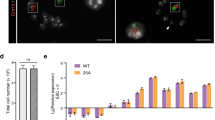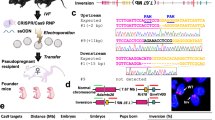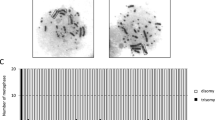Key Points
-
Strategies have recently been developed that allow defined chromosomal rearrangements to be introduced into the mouse genome by engineering them in embryonic stem (ES) cells using the Cre/loxP site-specific recombination system. These rearrangements include chromosomal deletions, duplications, inversions and translocations.
-
Using these strategies, mouse models that accurately recapitulate human chromosomal rearrangements that cause disease have been generated. These include chromosomal translocations that are associated with leukaemia and chromosomal deletions, such as those that cause DiGeorge syndrome and Prader–Willi syndrome.
-
Chromosomal-engineering technology has also been used to generate genetic reagents for the functional analysis of the mouse genome. Deletion chromosomes that are marked by, for example, coat-colour markers, have been engineered to provide segmental haploidy in the mouse genome, and are used to detect recessive mutations that are generated in ethylnitrosourea (ENU) mutagenesis screens.
-
Mouse balancer chromosomes have also been developed using Cre/loxP technology, by tagging chromosomal inversions with recessive lethal mutations and coat-colour markers, for use in ENU mutagenesis screens. These chromosomes facilitate the detection of recessive mutations in the absence of genotypic analysis and allow recessive lethal mutations to be maintained.
-
Although the applications of chromosomal engineering technologies are still in their infancy, they are likely to become invaluable for mapping genetic loci, such as quantitative trait loci, in the future. Marked deletions and balancer chromosomes will also continue to gain importance in large-scale, recessive genetic screens in mice and will significantly contribute to the functional annotation of the mouse genome.
Abstract
The combination of gene-targeting techniques in mouse embryonic stem cells and the Cre/loxP site-specific recombination system has resulted in the emergence of chromosomal-engineering technology in mice. This advance has opened up new opportunities for modelling human diseases that are associated with chromosomal rearrangements. It has also led to the generation of visibly marked deletions and balancer chromosomes in mice, which provide essential reagents for maximizing the efficiency of large-scale mutagenesis efforts and which will accelerate the functional annotation of mammalian genomes, including the human genome.
This is a preview of subscription content, access via your institution
Access options
Subscribe to this journal
Receive 12 print issues and online access
$189.00 per year
only $15.75 per issue
Buy this article
- Purchase on Springer Link
- Instant access to full article PDF
Prices may be subject to local taxes which are calculated during checkout







Similar content being viewed by others
References
Epstein, C. J. The Consequences of Chromosome Imbalance: Principles, Mechanism and Models (Cambridge Univ. Press, Cambridge, UK, 1986).
Shaffer, L. G. & Lupski, J. R. Molecular mechanisms for constitutional chromosomal rearrangements in humans. Annu. Rev. Genet. 34, 297–329 (2000).
Rabbitts, T. H. Chromosomal translocations in human cancer. Nature 372, 143–149 (1994).
Russell, W. L. X-ray induced mutations in mice. Cold Spring Harbor Symp. Quant. Biol. 16, 327–336 (1951).
Russell, L. B. et al. Chlorambucil effectively induces deletion mutations in mouse germ cells. Proc. Natl Acad. Sci. USA 86, 3704–3708 (1989).
Davisson, M. T., Schmidt, C. & Akeson, E. C. Segmental trisomy of murine chromosome 16: a new model system for studying Down syndrome. Prog. Clin. Biol. Res. 360, 263–280 (1990).
Roderick, T. in Utilization of Mammalian Specific-Locus Studies in Hazard Evaluation and Estimation of Genetic Risk (ed. de-Serres, F. & Sheridan, W.) 135–167 (Plenum, New York, 1983).
Stubbs, L., Carver, E. A., Cacheiro, N. L., Shelby, M. & Generoso, W. Generation and characterization of heritable reciprocal translocations in mice. Methods 13, 397–408 (1997).
Reeves, R. H. et al. A mouse model for Down syndrome exhibits learning and behaviour deficits. Nature Genet. 11, 177–184 (1995).
Rinchik, E. M. & Russell, L. B. in Genome Analysis Vol. I (ed. Davies, K. & Tilghman, S.) 121–158 (CSH Laboratory Press, Cold Spring Harbor, 1990).
Rinchik, E. M. Developing genetic reagants to facilitate recovery, analysis, and maintenance of mouse mutations. Mamm. Genome 11, 489–499 (2000).
Ramirez-Solis, R., Liu, P. & Bradley, A. Chromosome engineering in mice. Nature 378, 720–724 (1995).This is the first paper to describe the generation of megabase genomic rearrangements in mice by using chromosomal engineering technology.
Lindsay, E. A. et al. Congenital heart disease in mice deficient for the DiGeorge syndrome region. Nature 401, 379–383 (1999).
Tsai, T. F., Jiang, Y. H., Bressler, J., Armstrong, D. & Beaudet, A. L. Paternal deletion from Snrpn to Ube3a in the mouse causes hypotonia, growth retardation and partial lethality and provides evidence for a gene contributing to Prader–Willi syndrome. Hum. Mol. Genet. 8, 1357–1364 (1999).
Buchholz, F., Refaeli, Y., Trumpp, A. & Bishop, J. M. Inducible chromosomal translocation of AML1 and ETO genes through Cre/loxP-mediated recombination in the mouse. EMBO Rep. 1, 133–139 (2000).
Collins, E. C., Pannell, R., Simpson, E. M., Forster, A. & Rabbitts, T. H. Inter-chromosomal recombination of Mll and Af9 genes mediated by cre–loxP in mouse development. EMBO Rep. 1, 127–132 (2000).
Merscher, S. et al. TBX1 is responsible for cardiovascular defects in velo-cardio-facial/DiGeorge syndrome. Cell 104, 619–629 (2001).
Lindsay, E. A. et al. Tbx1 haploinsufficieny in the DiGeorge syndrome region causes aortic arch defects in mice. Nature 410, 97–101 (2001).
Zheng, B., Mills, A. A. & Bradley, A. A system for rapid generation of coat color-tagged knockouts and defined chromosomal rearrangements in mice. Nucleic Acids Res. 27, 2354–2360 (1999).
Zheng, B. et al. Engineering a mouse balancer chromosome. Nature Genet. 22, 375–378 (1999).This study describes the first mouse balancer chromosome to be developed using chromosomal engineering techniques.
Justice, M. J. in Mouse Genetics and Transgenics (eds Jackson, I. J. & Abbott, C. M.) 185–215 (Oxford Univ. Press, New York, 2000).
Dietrich, W. F. et al. A comprehensive genetic map of the mouse genome. Nature 380, 149–152 (1996); erratum 381, 172 (1996).
Flaherty, L. & Herron, B. The new kid on the block — a whole genome mouse radiation hybrid panel. Mamm. Genome 9, 417–418 (1998).
Li, Z. W. et al. Generation of mice with a 200-kb amyloid precursor protein gene deletion by Cre recombinase-mediated site-specific recombination in embryonic stem cells. Proc. Natl Acad. Sci. USA 93, 6158–6162 (1996); erratum 93, 12052 (1996).
Zheng, B., Sage, M., Sheppeard, E. A., Jurecic, V. & Bradley, A. Engineering mouse chromosomes with Cre–loxP: range, efficiency, and somatic applications. Mol. Cell. Biol. 20, 648–655 (2000).
Liu, P., Zhang, H., McLellan, A., Vogel, H. & Bradley, A. Embryonic lethality and tumorigenesis caused by segmental aneuploidy on mouse chromosome 11. Genetics 150, 1155–1168 (1998).
Ramirez-Solis, R., Davis, A. C. & Bradley, A. in Guide to Techniques in Mouse Development Vol. 225 (eds Wassarman, P. M. & DePamphilis, M. L.) 855–878 (Academic Press, Inc., San Diego, 1993).
Bradley, A., Zheng, B. & Liu, P. Thirteen years of manipulating the mouse genome: a personal history. Int. J. Dev. Biol. 42, 943–950 (1998).
O'Gorman, S., Dagenais, N. A., Qian, M. & Marchuk, Y. Protamine–Cre recombinase transgenes efficiently recombine target sequences in the male germ line of mice, but not in embryonic stem cells. Proc. Natl Acad. Sci. USA 94, 14602–14607 (1997).
Schlake, T. et al. Predetermined chromosomal deletion encompassing the Nf-1 gene. Oncogene 18, 6078–6082 (1999).
Zhu, Y. et al. Genomic interval engineering of mice identifies a novel modulator of triglyceride production. Proc. Natl Acad. Sci. USA 97, 1137–1142 (2000).
Madsen, L. et al. Mice lacking all conventional MHC class II genes. Proc. Natl Acad. Sci. USA 96, 10338–10343 (1999).
Su, H., Wang, X. & Bradley, A. Nested chromosomal deletions induced with retroviral vectors in mice. Nature Genet. 24, 92–95 (2000).This paper described a strategy for efficiently generating nested chromosomal deletions using a recombinant retrovirus. This approach also facilitates the identification of nested end points.
LePage, D. F., Church, D. M., Millie, E., Hassold, T. J. & Conlon, R. A. Rapid generation of nested chromosomal deletions on mouse chromosome. Part 2. Proc. Natl Acad. Sci. USA 97, 10471–10476 (2000).
You, Y. et al. Chromosomal deletion complexes in mice by radiation of embryonic stem cells. Nature Genet. 15, 285–288 (1997).
Thomas, J. W., LaMantia, C. & Magnuson, T. X-ray-induced mutations in mouse embryonic stem cells. Proc. Natl Acad. Sci. USA 95, 1114–1119 (1998).
Kushi, A. et al. Generation of mutant mice with large chromosomal deletion by use of irradiated ES cells — analysis of large deletion around hprt locus of ES cell. Mamm. Genome 9, 269–273 (1998).
Smith, A. J. et al. A site-directed chromosomal translocation induced in embryonic stem cells by Cre–loxP recombination. Nature Genet. 9, 376–385 (1995); erratum 12, 110 (1996).
Van Deursen, J., Fornerod, M., Van Rees, B. & Grosveld, G. Cre-mediated site-specific translocation between nonhomologous mouse chromosomes. Proc. Natl Acad. Sci. USA 92, 7376–7380 (1995).References 38 and 39 introduce the use of targeted Cre/ loxP strategies for generating chromosomal translocations in mouse embryonic stem cells.
Lyon, M. F. & Meredith, R. Autosomal translocations causing male sterility and viable aneuploidy in the mouse. Cytogenetics 5, 335–354 (1966).
Scambler, P. J. The 22q11 deletion syndromes. Hum. Mol. Genet. 9, 2421–2426 (2000).
Dunham, I. et al. The DNA sequence of human chromosome 22. Nature 402, 489–495 (1999); erratum 404, 904 (2000).
Herault, Y., Rassoulzadegan, M., Cuzin, F. & Duboule, D. Engineering chromosomes in mice through targeted meiotic recombination (TAMERE). Nature Genet. 20, 381–384 (1998).
Matsusaka, T. et al. Dual renin gene targeting by Cre-mediated interchromosomal recombination. Genomics 64, 127–131 (2000).
Antoch, M. P. et al. Functional identification of the mouse circadian Clock gene by transgenic BAC rescue. Cell 89, 655–667 (1997).
Hejna, J. A. et al. Functional complementation by electroporation of human BACs into mammalian fibroblast cells. Nucleic Acids Res. 26, 1124–1125 (1998).
Liu, P. et al. Requirement for Wnt3 in vertebrate axis formation. Nature Genet. 22, 361–365 (1999).
Mackay, T. F. Quantitative trait loci in Drosophila. Nature Rev. Genet. 2, 11–20 (2001).
Reeves, R. H., Baxter, L. L. & Richtsmeier, J. T. Too much of a good thing: mechanisms of gene action in Down syndrome. Trends Genet. 17, 83–88 (2001).
Sago, H. et al. Ts1Cje, a partial trisomy 16 mouse model for Down syndrome, exhibits learning and behavioral abnormalities. Proc. Natl Acad. Sci. USA 95, 6256–6261 (1998).
Hoess, R. H. & Abremski, K. in Nucleic Acids and Molecular Biology Vol. 4 (eds Eckstein, F. & Lilley, D. M. J.) 99–109 (Springer, Berlin and Heidelberg, 1990).
Sadowski, P. D. Site-specific genetic recombination: hops, flips, and flops. FASEB J. 7, 760–767 (1993).
Acknowledgements
We thank M. Wentland for comments on this manuscript and A. Pao for assistance in preparing the figures. Work in the authors' lab is supported by the National Institutes of Health, the Howard Hughes Medical Institute and the Wellcome Trust.
Author information
Authors and Affiliations
Supplementary information
Related links
Related links
DATABASES
FURTHER INFORMATION
Chromosome 11 ENU mutagenesis programme
Genetic and physical maps of the mouse genome
Glossary
- SEGMENTAL HAPLOIDY
-
When a diploid organism is haploid for a certain chromosomal region after its deletion or loss.
- BALANCER CHROMOSOME
-
A chromosome with one or more inverted segments that suppress recombination. They are used as genetic tools because they allow lethal mutations to be maintained without selection.
- CROSSING OVER
-
The exchange of genetic material between two homologous chromosomes.
- BLASTOCYST
-
A preimplantation embryo that contains a fluid-filled cavity called a blastocoel.
- POSITIVE SELECTION
-
When a specific chemical is added to a culture medium, the cells that express a positive selectable marker gene, such as the neomycin or puromycin resistance genes, survive and are selected for.
- HPRT MINIGENE
-
(Hypoxanthine phosphoribosyl transferase gene). This is divided into two complementary, but non-functional, fragments: 5′Hprt contains exons 1–2 and 3′Hprt contains the remaining exons, 3–9. Each Hprt fragment is linked to a loxP site, and Cre-mediated recombination unites the 5′ and 3′ cassettes, and restores Hprt activity, which is required for purine biosynthesis and allows desired recombination events to be selected for in HAT (hypoxanthine, aminopterin and thymidine) medium.
- ACENTRIC
-
A chromosome or chromatid without a centromere.
- DICENTRIC
-
A chromatid or a chromosome that has two centromeres.
- K14–AGOUTI
-
A transgene in which the agouti gene is under the control of the keratin 14 promoter. Its expression produces a yellowish coat colour in mice.
- TYROSINASE
-
Tyrosinase is required for melanin biosynthesis, and the expression of its gene leads to pigment production, and is therefore used as a coat-colour marker.
- HSVTK
-
The herpes simplex virus thymidine kinase (HSVtk) is essential for thymidine nucleotide biosynthesis through a salvage pathway and is often used as a negative selectable marker in gene targeting.
- NEGATIVE SELECTABLE MARKER
-
A negative selectable marker gene, such as HSVtk, allows cells that express it to be killed when a specific chemical is added to a culture medium, whereas cells that no longer express the marker gene survive.
- HAPLOINSUFFICIENCY
-
A phenotype that arises in diploid organisms owing to the loss of one functional copy of a gene.
- HYBRID ES-CELL LINE
-
An embryonic stem (ES) cell line isolated from F1 hybrid embryos, such as from crosses between the strains C57BL/6-Tyrc1Brd × 129S7 or 129S1 × CAST/Ei. These lines facilitate simple sequence length polymorphism analysis.
- ENU
-
(N-ethyl-N-nitrosourea). A potent mutagen that primarily generates single-base-pair mutations in mouse spermatogonia germ cells.
Rights and permissions
About this article
Cite this article
Yu, Y., Bradley, A. Engineering chromosomal rearrangements in mice. Nat Rev Genet 2, 780–790 (2001). https://doi.org/10.1038/35093564
Issue Date:
DOI: https://doi.org/10.1038/35093564
This article is cited by
-
Efficient targeted recombination with CRISPR/Cas9 in hybrids of Caenorhabditis nematodes with suppressed recombination
BMC Biology (2023)
-
One-step generation of zebrafish carrying a conditional knockout-knockin visible switch via CRISPR/Cas9-mediated intron targeting
Science China Life Sciences (2020)
-
Simple and large-scale chromosomal engineering of mouse zygotes via in vitro and in vivo electroporation
Scientific Reports (2019)
-
Site-specific chromosomal gene insertion: Flp recombinase versus Cas9 nuclease
Scientific Reports (2017)
-
One-step generation of mice carrying a conditional allele together with an HA-tag insertion for the delta opioid receptor
Scientific Reports (2017)



